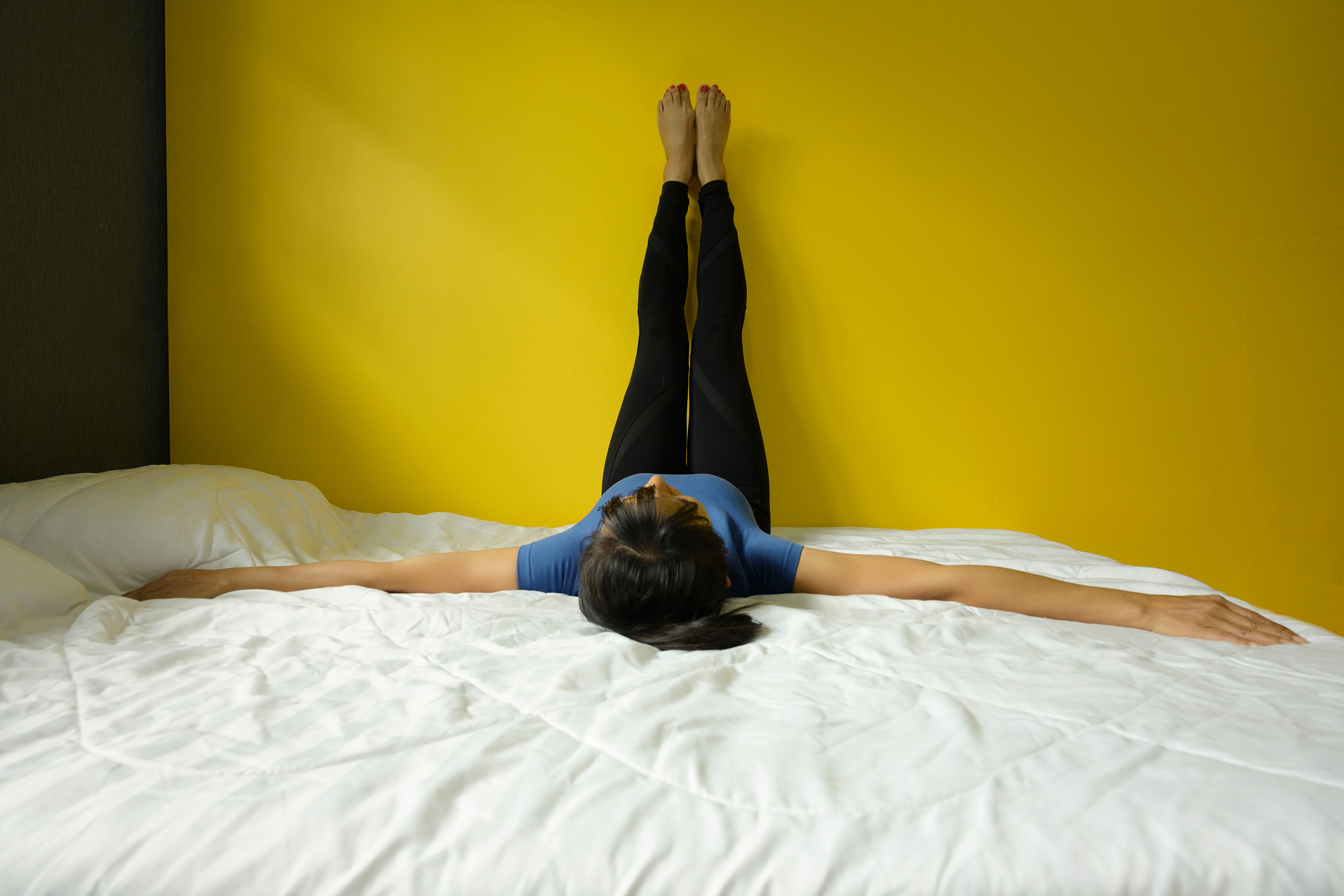A yoga pose that can benefit everyone—whatever your level
29 October 2019, Katie Michael

Legs up the wall: Viparia-Karani
It might seem strange that I have chosen legs up the wall (viparia-karani) as the first yoga pose (asana) to cover in depth in the blog. You might be surprised that lying with your legs up the wall is a yoga pose at all! You might also wonder what the benefits are. Lying with your legs up the wall is one of the most accessible yoga poses. It doesn’t require much strength or flexibility and is easy to get into. It is as useful for beginners as for advanced students and it is safe for most individuals, although those who are pregnant, have glaucoma, high blood pressure or any serious spinal problems should consult their doctor before trying. It has many benefits for a pose that is so simple.
It is a passive, restorative, gentle inversion making use of gravity. It relaxes the mind and body, gently stretches the lower back and lower limbs, and helps improve your body's venous and lymphatic circulation.
This pose is usually practiced at the end of a yoga class, before the final savasana, to help relax the mind and body. By adding some gentle equal breathing (sama vritti—“sama” means even and smooth, and “vritti” means fluctuations) and focusing on the breath by closing and softening your eyes, you can deepen the relaxation. It is said to help create a balance of the flow of consciousness, smoothing fluctuations of the mind into stillness.
To get into the pose
Start by shimmying your hips as close to a wall as possible (or lying in bed you can use your headboard), then start walking your feet up the wall until your body is in a somewhat L-shaped position. Make any adjustments to help your body feel relaxed. If you feel pulling in the hamstrings move farther away from the wall. Keep the lower back grounded to the floor/bed. Open your shoulder blades away from your spine and release your hands and arms out to your sides, palms up. Keep your legs relatively firm, just enough to hold them vertically in place. If this is difficult you might want to use a strap to place around your legs just below the knees to hold the legs upright, allowing you to relax further. Start to focus on your breath, taking a deep, slow inhale through your nose and a deep, slow exhale through your nose. Stay in the pose for at least five minutes for optimal benefits.
Main benefits
Relaxation
The semi-supine position combined with your breath work leads to a slowing down of your heart rate, stimulating your parasympathetic nervous system. This calms your mind, reduces feelings of stress which in turn can help with your sleep.
Improves circulation
Elevating the legs promotes drainage of any excess fluid that might have built up. This is helped by gravity assisting the circulation from your lower limbs to return the blood back to the heart. It also helps to reduce the strain on the heart by allowing blood to easily flow around the neck and chest with the help of gravity.
Reduces swollen or cramped legs and feet
Inverting the legs/feet is effective for reducing swelling and pain in the lower extremities. It is especially therapeutic after flying, physical activity or from the detrimental effects of sitting/standing during the day.
Balances hormones
If the throat lock (jalandhar bandha) is applied by bringing the chin back towards the neck and then resting it in the notch between the collar bones, it helps to put pressure on the thyroid and hypothalamus glands to stimulate their secretions and, in turn, activate the pituitary gland.
Reduces constipation
The change in gravitational pull on the body affects the abdominal organs so that the bowels move freely and constipation is relieved.
Reduces wrinkles in the face
Due to increased blood flow to the face, complexions can be improved with consistent practice.
Helps with sleep
It helps to promote deep sleep and is beneficial for people with insomnia.
Gently stretches the lower back and hamstrings
The angle of the body reduces the natural curve of the lumbar spine, which will help to elongate and stretch the back muscles. The closer your hips are to the wall, the more stretch you will create in your hamstrings. Try not to bring the body to a full 90 degree angle as this can impede circulation at the hips. Keep your hips a few inches from the wall and/or elevate your hips by placing a cushion or pillow under your sacrum.
Helps with lower back tension
The normal downward pressures from gravity are released from the spine (vertebral bodies) in a semi-supine position, which can help to relieve some lower back pain.
Pelvic floor
This position allows the pelvic muscles to naturally release and relax which helps with tense or tight pelvic floor muscles.
Stimulates the throat Chakra (the Visuddah)
Legs up the wall ignites the fifth chakra, which is associated with creativity and self-expression. When this chakra is open and balanced, our negative experiences can be transformed into wisdom and learning.
Added benefits have also been shown with some of the symptoms from the following
- Fibromyalgia (e.g. chronic pain)
- Venous disease (e.g. varicose veins)
- Menopause (e.g. hot flushes)
- Restless leg syndrome
- Metabolic syndromes
- Respiratory disease (e.g. asthmatics, bronchitis—reduces the strain on heart and respiratory systems bringing greater ease to the breath)
Variations of this pose
- Waterfall: place a block under sacrum to elevate the hips above the heart
- Shoulder stand (sarvangasana): “queen of all yoga postures”
As this pose is one of the most accessible to all levels of students and with its multiple benefits it must be the pose of all poses!
